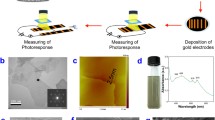Abstract
In this study, we investigate the influence of ultraviolet–ozone (UV–O3) treatment on the photodetection properties of multilayer-MoS2 films. The MoS2 thin film photodetectors were fabricated using a sequential spin coating process at low temperature. As UV–O3 exposure time was increased, a significant enhancement in the photodetector performance at both ultraviolet and visible-light ranges has been observed. After 5 min of exposure to UV–O3, a 99% increase in the photoresponsivity to UV radiation, at wavelength of 320 nm, was observed under light intensity of 300 µW cm−2. This remarkable improvement in UV detection was accompanied by a noteworthy enhancement through the whole visible range with a maximum responsivity of 128 A/W and a highest detectivity of 1.3 × 1012 Jones at 580 nm irradiation. On the infrared side, a drop of 13.6% in responsivity and around an order of magnitude reduction in detectivity were noticed for 750 nm irradiation after the 5 min UV–O3 treatment. All built detectors showed reliable photo-switching properties with response time of 0.22 s. Raman spectroscopy and X-ray photoelectron spectroscopy analysis suggest that the significant improvement of optoelectronic properties is caused by the passivation of localized Sulfur vacancies by O2 or oxygen ions that bond chemically with MoS2. Such findings provide a quick and simple route for modulating the optical properties of MoS2-based optoelectronics through a surface treatment.






Similar content being viewed by others
References
K. Kalantar-zadeh, J.Z. Ou, Biosensors based on two-dimensional MoS2. ACS Sens. 1(1), 5–16 (2016)
R. Ganatra, Q. Zhang, Few-layer MoS2: a promising layered semiconductor. ACS Nano 8(5), 4074–4099 (2014)
H.S. Nalwa, A review of molybdenum disulfide (MoS2) based photodetectors: from ultra-broadband, self-powered to flexible devices. RSC Adv. 10(51), 30529–30602 (2020)
K.F. Mak et al., Atomically thin MoS(2): a new direct-gap semiconductor. Phys. Rev. Lett. 105(13), 136805 (2010)
W. Jing et al., Ag nanoparticles modified large area monolayer MoS2 phototransistors with high responsivity. Opt. Expr. 25(13), 14565–14574 (2017)
Y. Huang et al., Effects of organic molecules with different structures and absorption bandwidth on modulating photoresponse of MoS2 photodetector. ACS Appl. Mater. Interfaces. 8(35), 23362–23370 (2016)
E. Kim et al., Tuning the optical and electrical properties of MoS2 by selective Ag photo-reduction. Appl. Phys. Lett. 113(1), 013105 (2018)
G. Yoo et al., Enhanced photoresponsivity of multilayer MoS2 transistors using high work function MoOx overlayer. Appl. Phys. Lett. 110(5), 053112 (2017)
D.B. Velusamy et al., 2D Organic-inorganic hybrid thin films for flexible UV-visible photodetectors. Adv. Func. Mater. 27(15), 1605554 (2017)
H. Badahdah et al., Solution processed near-infrared photodetectors using hybrid MoS2-P(Py-co-OT) composite films. Mater. Res. Bull. 138, 111229 (2021)
C. Jung, H.I. Yang, W. Choi, Effect of ultraviolet–ozone treatment on MoS2 monolayers: comparison of chemical-vapor-deposited polycrystalline thin films and mechanically exfoliated single crystal flakes. Nanoscale Res Lett 14(1), 278 (2019)
A. Rai et al., Progress in contact, doping and mobility engineering of mos2: an atomically thin 2D semiconductor. Curr. Comput.-Aided Drug Des. 8(8), 316 (2018)
H. Nan et al., Improving the electrical performance of MoS2 by mild oxygen plasma treatment. J. Phys. D: Appl. Phys. 50, 154001 (2017)
H.I. Yang, S. Park, W. Choi, Modification of the optoelectronic properties of two-dimensional MoS2 crystals by ultraviolet–ozone treatment. Appl. Surf. Sci. 443, 91–96 (2018)
W. Su et al., Transforming bilayer MoS2 into single-layer with strong photoluminescence using UV–ozone oxidation. Nano Res. 8(12), 3878–3886 (2015)
S. KC et al., Surface oxidation energetics and kinetics on MoS2 monolayer. J. Appl. Phys. 117(13), 135301 (2015)
J. Liu et al., Evolutions of morphology and electronic properties of few-layered MoS2 exposed to UVO. Res. Phys. 19, 103634 (2020)
J. Jadwiszczak et al., Photoresponsivity enhancement in monolayer MoS2 by rapid O2: Ar plasma treatment. Appl. Phys. Lett. 114(9), 091103 (2019)
J. Guo et al., Observation of abnormal mobility enhancement in multilayer MoS2 transistor by synergy of ultraviolet illumination and ozone plasma treatment. Physica E 87, 150–154 (2017)
Vijith, K.P. and M.A.G. Namboothiry, Effect of oxygen incorporation in the photoconductivity of two-dimensional MoS2, in Proceedings of the International Conference on Advanced Materials: Icam 2019. 2019.
C. Xie et al., Photodetectors based on two-dimensional layered materials beyond graphene. Adv. Func. Mater. 27(19), 1603886 (2017)
X. Cui, Achieving Ohmic Contact for High-quality MoS2 Devices on Hexagonal Boron Nitride, in Graduate School of Arts and Sciences (Columbia University, New York, 2018)
Y. Shimazu, K. Arai, T. Iwabuchi, Contact-induced doping in aluminum-contacted molybdenum disulfide. Jpn. J. Appl. Phys. 57(1), 015801 (2017)
H. Lee et al., High-Responsivity multilayer MoSe2 phototransistors with fast response time. Sci. Rep. 8(1), 11545 (2018)
W. Zhong et al., Feasible route for a large area few-layer MoS2 with magnetron sputtering. Nanomaterials (Basel, Switzerland) 8(8), 590 (2018)
B.C. Windom, W.G. Sawyer, D.W. Hahn, A Raman spectroscopic study of MoS2 and MoO3: applications to tribological systems. Tribol. Lett. 42(3), 301–310 (2011)
Alexander V. Naumkin, A.K.-V., Stephen W. Gaarenstroom, and Cedric J. Powell, NIST X-ray Photoelectron Spectroscopy Database, in NIST Standard Reference Database 20, Version 4.1. 2012.
Author information
Authors and Affiliations
Corresponding author
Additional information
Publisher's Note
Springer Nature remains neutral with regard to jurisdictional claims in published maps and institutional affiliations.
Supplementary Information
Below is the link to the electronic supplementary material.
Rights and permissions
About this article
Cite this article
Al-Jawhari, H., Badahdah, H., Mudhaffar, A. et al. Modulating the detection performance of solution processed stacked multilayer-MoS2 photodetectors upon ultraviolet–ozone surface treatment. Appl. Phys. A 128, 101 (2022). https://doi.org/10.1007/s00339-022-05263-z
Received:
Accepted:
Published:
DOI: https://doi.org/10.1007/s00339-022-05263-z




